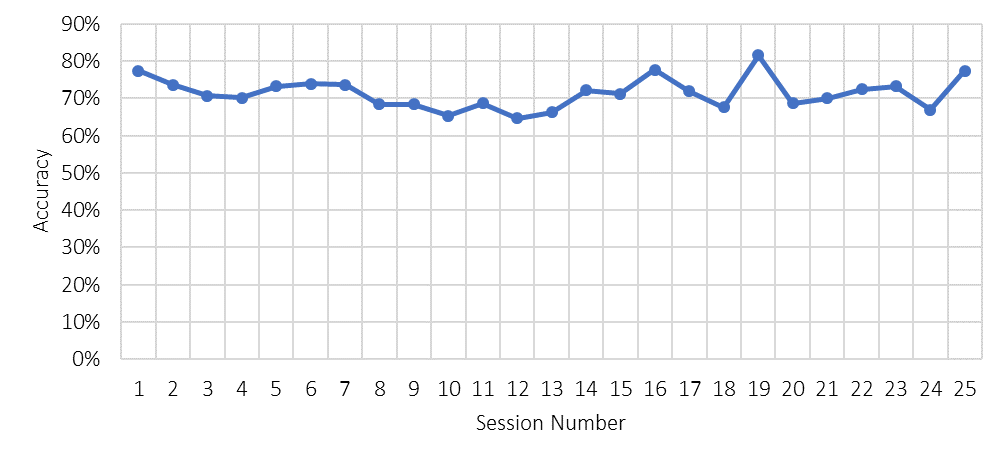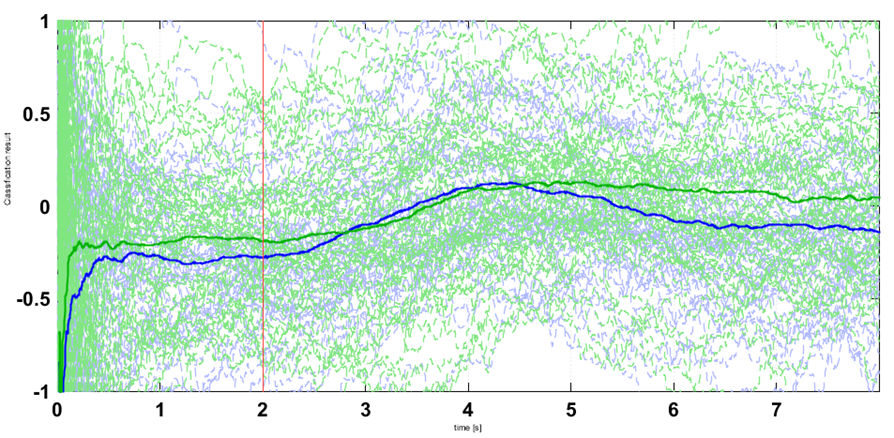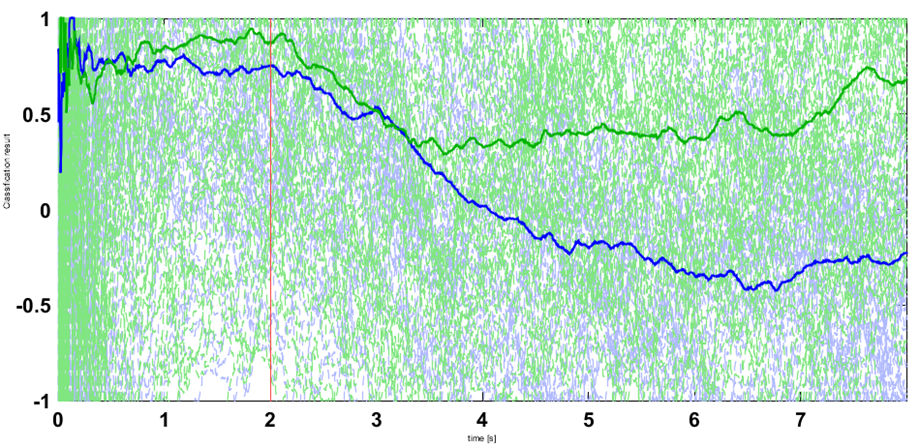Motor Improvements from recoveriX Therapy 30 Years After Stroke
Interviews Patient's SuccessGaby Inakaria suffered a stroke 30 years ago. When she started with recoveriX therapy, she was 54 years old. The stroke affected her left side and caused spasticity, tremor and movement restrictions of upper and lower limbs. After the recoveriX therapy, she said: “My hand didn’t belong to me. But after recoveriX therapy, my hand feels like mine again.” Mrs. Inkaria was paralyzed on her left side and wasn’t able to move her arm and foot. The sudden improvement surprised her the most when she caught herself brushing her teeth with her disabled hand. Here are the recoveriX results from Gaby.
You are currently viewing a placeholder content from Youtube. To access the actual content, click the button below. Please note that doing so will share data with third-party providers.
Christoph, can you explain what kind of stroke rehabilitation Gaby had at the recoveriX gym 30 years after her stroke?
Christoph Guger: “Altogether, our physiotherapists performed 25 recoveriX sessions with her. Each session lasted 40 minutes. During each session, she imagined moving either her left or right hand while a physiotherapist helped her. We used machine learning algorithms to differentiate between left and right hand movement imagination. ”She reached a mean accuracy of 71.5 % in all training sessions. This shows that she was actively engaged in the recoveriX sessions. The chart shows the classification accuracy of every single recoveriX session.”

Christoph Guger: The figures below show that, in the first session, the BCI system was just starting to learn how to differentiate left vs. right movement imagination. The physiotherapist asked the patient to imagine either left or right hand movement at second 2 in the training, shown by the red line. The green solid line shows the mean BCI output for left hand movement imagination, and the dotted lines are the 100 single repetitions of the hand movement imagination. The blue line represents the results for the right hand movement imagination.”
 Before recoveriX therapy
Before recoveriX therapy
You used the Fugl-Meyer Scale to describe motor functions. What did you see?
Christoph Guger: Just before the first recoveriX therapy, we tested Gaby with the Fugl-Meyer Assessment for the upper extremities (that is, the arms), and she reached a total score of 17 points. The maximum score possible is 66, which would reflect completely healthy movement, so Gaby’s score showed that she had a lot of trouble with movement. The tests in the Fugl-Meyer Assessment measure functions of upper extremity, wrist, hand and coordination and speed. Her wrist function was especially limited, and she scored 0 points on wrist function.
Then, Gaby participated in 25 recoveriX training sessions within 3 months. Afterwards, she participated in three assessments in April, June and September. The total upper extremity score improved continuously from 17 to 37 points. In April she reached 28 points, in June she reached 35 points, and finally, she reached 37 points in September. A total improvement of 20 points is a very impressive result, and you have to remember that this happened 30 years after the stroke. Gaby’s wrist function even improved because of the therapy. This increase shows that patients are still improving after the recoveriX therapy was finished, because patients are more often using their hands again. Additionally, passive joint motion improved, she had less pain and more sensation because of the therapy.

The FMA improvement is very impressive. What does it actually mean for a patient?
Christoph Guger: The FMA improvement means that the patient improves in performing activities of their daily lives, such as using a knife and a fork to eat. The patient told us that she could hold a tooth brush and open a door knob with her affected hand after the therapy. In addition to the Fugl-Meyer Assessment, we also used the 9-Hole Peg Test to figure out how much her fine motor skills improved. Gaby could not do the test properly before session 21, or needed more than one hour to complete it. After 25 recoveriX sessions, she only needed about 17 minutes. And when we checked her skills in the Post Assessment in September again, she could event manage the 9-Hole Peg Test within 5 minutes and 36 seconds. This shows that her fine motor skills improved even further after the therapy was already finished.
| 9-HOLE PEG TEST | LEFT HAND (AFFECTED) |
| Pre-Testing in February 2017 | Not possible |
| 1. recoveriX session | Not possible |
| 11. recoveriX session | 1,5 points |
| 17. recoveriX session | > 1 hours |
| 18. recoveriX session | > 1 hours |
| 21. recoveriX session | > 1 hours |
| 1. Post-Testing in April 2017 | 17:16 Minutes |
| 2. Post-Testing in June 2017 | 16:18 Minutes |
| 3. Post-Testing in September 2017 | 05:36 Minutes |
This means that the recoveriX therapy success continued to have a positive effect on her motor functions after therapy is already finished?
Christoph Guger: That’s right. And this is of course very important. recoveriX reduces spasticity, tremor and increases motor functions and therefore patients start to use their limbs and hands more often which has of course also a positive effect. For that reason, we see very often an improvement even when the therapy was finished. To monitor her tremor improvements, we are using the Fahn Tremor scale. In this case, the patient has to draw spirals and lines, and the therapist evaluates how well the patient can do it. The following pictures show the results of the Fahn Tremor test before recoveriX (orange pen) and after the recoveriX therapy (blue pen).

Christoph Guger: Gaby’s left hand was very much affected by the stroke. She had a strong tremor, which you can see in the pictures before therapy. After the therapy, she was able to control her left hand better, so she could do the drawing with less tremor and without hitting the borders. For Gaby especially, the Ashworth scale for the wrist showed a decrease in tremor from 3-4 points to only 1 point, and this is one of the explanations why she can do much more daily activities after the therapy. We are also looking at the Barthel Index, which measures how well patients can perform daily activities, and it also increased. Furthermore, in the Box and Block test, she could move 7 blocks into the basket after her therapy.
Before recoveriX, she couldn’t grab one single block. The following videos demonstrate the improvements of the hand functions. Before recoveriX therapy, the hand shows a minimum of wrist dorsiflexion. After recoveriX therapy, the wrist and finger functions have clearly improved. The pre-Testing video shows Gaby’s minimum wrist dorsiflexion; The post-testing video shows more wrist and finger movement after the therapy.
This improvement was possible 30 years after her stroke. How is this possible?
Christoph Guger: When we treat a patient with recoveriX we are combining three therapies into one: functional electrical stimulation, immersive VR therapy and motor imagination. The system also pairs cognitive functions with motor behavior. A patient has to repeat the motor movement imaginations about 5000 times, which helps the brain re-learn how to control the limbs. We have now seen many times that these improvements happen many years after the stroke. Therefore, it is never too late to start with the therapy.


